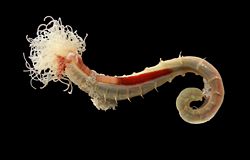| Terebellidae | |
|---|---|
 | |
| Lanice conchilega (Terebellinae), taken out of its burrow. Note "spaghetti" tentacles on head. | |
| Scientific classification | |
| Kingdom: | Animalia |
| Phylum: | Annelida |
| Clade: | Pleistoannelida |
| Clade: | Sedentaria |
| Order: | Terebellida |
| Suborder: | Terebellomorpha |
| Family: | Terebellidae Grube, 1851 |
| Subfamilies | |
4, see text | |
The Terebellidae is a marine family of polychaete worms, of which the type taxon is Terebella , described by Carl Linnaeus in his 1767 12th edition of Systema Naturae. [1]




